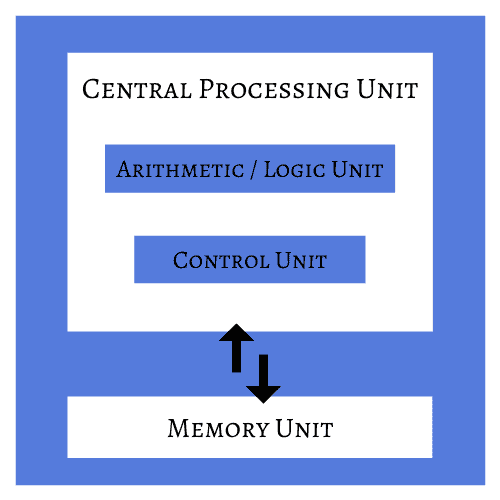1. 简介
如今,大家普遍都知道计算机是通过处理由 0 和 1 构成的二进制序列来完成各种复杂任务的。但你有没有想过,这个过程到底是怎么实现的?
在汇编语言出现之前,程序员需要直接使用数字代码来编写程序,这在当时是一项非常繁琐且容易出错的工作。1949 年,EDSAC 计算机首次引入了汇编语言,大大提升了编程效率。本文将带你了解汇编语言的基本概念和使用方式。
如果你对计算机底层原理感兴趣,或者希望了解程序是如何在 CPU 上执行的,那么本文将是一个不错的起点。
2. 理论背景
要理解汇编语言的作用,我们需要先了解编程语言的抽象层级和计算机的基本架构。
2.1 编程语言的抽象层级
编程语言可以分为三个主要层级:
✅ 机器语言(Machine Code)
这是 CPU 能直接识别的二进制指令,由 0 和 1 构成。虽然执行效率高,但对人类来说几乎无法阅读。
✅ 低级语言(Low-Level Language)
汇编语言就是其中的代表。它使用助记符(mnemonics)来代替二进制指令,例如 ADD 表示加法操作。汇编语言需要通过 汇编器(Assembler) 转换为机器语言。
✅ 高级语言(High-Level Language)
如 Java、Python、C++ 等,接近自然语言,易于理解和编写。它们需要通过 编译器(Compiler) 或 解释器(Interpreter) 转换为机器语言。
2.2 计算机架构
现代计算机大多基于冯·诺依曼架构(von Neumann Architecture),其核心组件包括:
- 内存单元(Memory Unit):用于存储程序和数据
- 算术逻辑单元(ALU):执行数学和逻辑运算
- 控制单元(CU):控制程序执行流程
冯·诺依曼架构的一个关键特性是:程序和数据存储在同一个内存空间中。这使得程序可以动态修改自身,提高了灵活性和执行效率。
CPU 内部还包含多个寄存器(Registers),它们是 CPU 用于快速访问和处理数据的高速临时存储单元。在汇编语言中,很多操作都是通过直接操作寄存器完成的。
下图展示了一个典型的 CPU 架构:

3. 汇编语言示例
为了更直观地理解汇编语言的运行机制,我们来看两个简单的 MIPS 汇编示例,并与对应的 Python 实现进行对比。
3.1 Hello World 示例
MIPS 汇编代码如下:
.text # 代码段
.globl main # main 是程序入口
main:
li $v0,4 # 设置系统调用号 4,表示输出字符串
la $a0, msg # 将字符串地址加载到寄存器 a0
syscall # 调用系统输出函数
li $v0,10 # 设置系统调用号 10,表示退出程序
syscall # 执行退出
.data # 数据段
msg: .asciiz "Hello World!\n"
对应的 Python 代码非常简单:
print("Hello World")
3.2 求 1 到 N 的累加和
MIPS 汇编代码如下:
.text
.globl main
main:
li $v0,4 # 输出提示信息
la $a0, msg1
syscall
li $v0,5 # 读取用户输入整数 N
syscall
move $t0, $v0 # 将 N 存入 t0 寄存器
li $t1, 0 # 初始化计数器 i
li $t2, 0 # 初始化累加和 sum
loop: addi $t1, $t1, 1 # i = i + 1
add $t2, $t2, $t1 # sum = sum + i
beq $t0, $t1, exit # 如果 i == N,跳转到 exit
j loop # 否则跳回 loop 继续循环
exit: li $v0, 4
la $a0, msg2
syscall
li $v0,1 # 输出累加结果
move $a0, $t2
syscall
li $v0,4
la $a0, lf
syscall
li $v0,10 # 退出程序
syscall
.data
msg1: .asciiz "\nNumber of integers N? "
msg2: .asciiz "\nSum = "
lf: .asciiz "\n"
对应的 Python 代码如下:
def example(n):
return sum(range(n+1))
n = int(input("Number of integers N? "))
print("Sum = ", example(n))
⚠️ 虽然 Python 版本看起来简洁很多,但背后是高级语言对底层逻辑的高度封装。而汇编版本则让我们更清楚地看到 CPU 是如何一步步执行每条指令的。
4. 总结
通过上面的示例可以看出,用汇编语言完成一个简单的功能都需要编写大量代码。对于现代复杂应用,比如 3D 游戏、网页应用等,用汇编开发几乎不可行。
但汇编语言并非过时技术。在以下场景中,它依然具有不可替代的价值:
✅ 嵌入式系统开发:资源受限,需要极致优化
✅ 实时系统:对响应时间有严格要求
✅ 性能关键模块:如操作系统内核、驱动程序等
在这些领域,开发者需要对 CPU 操作有完全控制权,而汇编语言正好提供了这种能力。
如果你想深入了解程序在底层是如何运行的,学习汇编语言是一个非常有价值的选择。它不仅有助于你更好地理解计算机体系结构,还能提升你在性能调优、逆向工程、漏洞挖掘等领域的实战能力。